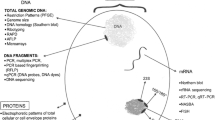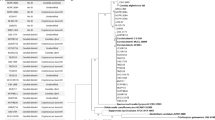Abstract
An otherwise healthy 22-year-old man presented with Acanthamoeba keratitis (AK) in the right eye. He was not a contact lens wearer and had no history of corneal trauma. The Acanthamoeba strain isolated from a corneal scraping was identified as morphological group II and genotype T4. Three more Acanthamoeba strains isolated from sites of possible human contact with acanthamoebae in the same geographical region, including a lens storage case, tap water and soil, were subjected to morphological and molecular biological identification. Whereas the strain from tap water also exhibited genotype T4, the two other isolates were identified as morphological group I and genotype T9. To the best of our knowledge, this is the first study identifying an AK-causing Acanthamoeba strain in Turkey and the first isolation of genotype T9 in this country.

Similar content being viewed by others
References
Akisü Ç, Baka M, Durak I, Orhan V (1999) A case of Acanthamoeba keratitis: light and electron microscope findings. Acta Parasitol Turc 23:340–342
Akyol N, Aşçı Z, Kükner S (1996) Acanthamoeba keratitis: the first reported case from Turkey. Ophtal Practice Asia Ed 2:46–48
Barker J, Brown MR (1994) Trojan horses of the microbial world: protozoa and the survival of bacterial pathogens in the environment. Microbiology 140:1253–1259
Booton GC, Kelly DJ, Chu Y-W, Seal DV, Houang E, Lam DSM, Byers TJ, Fuerst PA (2002) 18S ribosomal DNA typing and tracking of Acanthamoeba species isolates from corneal scrape specimens, contact lenses, lens cases, and home water supplies of Acanthamoeba keratitis patients in Hong Kong. J Clin Microbiol 40:1621–1625
De Jonckheere JF (1991) Ecology of Acanthamoeba. Rev Infect Dis 13:385–387
Demirci G, Ay GM, Karabas LV, Altintas O, Tamer GS, Caglar Y (2006) Acanthamoeba keratitis in a 5-year-old boy without a history of contact lens usage. Cornea 25:356–358
Gast RJ (2001) Development of an Acanthamoeba-specific reverse dot-blot and the discovery of a new ribotype. J Eukaryot Microbiol 48:609–615
Gast RJ, Ledee DR, Fuerst PA, Byers TJ (1996) Subgenus systematics of Acanthamoeba: four nuclear 18S rDNA sequence types. J Eukaryot Microbiol 43:498–504
Gray TB, Cursons RT, Sherwan JF, Rose PR (1995) Acanthamoeba, bacterial, and fungal contamination of contact lens storage cases. Br J Ophthalmol 79:601–605
Hewett MK, Robinson BS, Monis PT, Saint CP (2003) Identification of a new Acanthamoeba 18S rRNA gene sequence type, corresponding to the species Acanthamoeba jacobsi Sawyer, Nerad and Visvesvara, 1992 (Lobosea: Acanthamoebidae). Acta Protozool 42:325–329
Hiti K, Faschinger C, Haller-Schober EM, Hiti H, Walochnik J, Aspöck H (2000) Acanthamoeba in asymptomatic contact lens wearers? Examination of storage-boxes. Spektrum Augenheilkd 14:163–166
Horn M, Wagner M (2004) Bacterial endosymbionts of free-living amoebae. J Eukaryot Microbiol 51:509–514
Horn M, Fritsche TR, Gautom RK, Schleifer K, Wagner M (1999) Novel bacterial endosymbionts of Acanthamoeba spp. related to the Paramecium caudatum symbiont Caedibacter caryphilus. Environ Microbiol 1:357–367
Hugo ER, Stewart VJ, Gast RJ, Byers TJ (1992) Purification of amoeba mtDNA using the UNSET procedure. In: Soldo AT, Lee JJ (eds) Protocols in Protozoology. Allen Press, Lawrence, Kansas, PD-7.1
Khan NA, Paget TA (2002) Molecular tools for speciation and epidemiological studies of Acanthamoeba. Curr Microbiol 44:444–449
Khan NA, Jarroll EL, Paget TA (2002) Molecular and physiological differentiation between pathogenic and non-pathogenic Acanthamoeba. Curr Microbiol 45:197–202
Kilic A, Tanyuksel M, Sissons J, Jayasekera S, Khan N (2004) Isolation of Acanthamoeba isolates belonging to T2, T3, T4, and T7 genotypes from environmental samples in Ankara, Turkey. Acta Parasitol 49:246–252
Kilvington S, White DG (1994) Acanthamoeba: biology, ecology and human disease. Rev Med Microbiol 5:12–20
Kilvington S, Gray T, Dart J, Morlet N, Beeching JR, Frazer DG, Matheson M (2004) Acanthamoeba keratitis: the role of domestic tap water contamination in the United Kingdom. Invest Ophthalmol Vis Sci 45:165–169
Liu H, Moon EK, Yu HS, Jeong HJ, Hong YC, Kong HH, Chung DI (2005) Evaluation of taxonomic validity of four species of Acanthamoeba: A. divionensis, A. paradivionensis, A. mauritaniensis, and A. rhysodes, inferred from molecular analyses. Korean J Parasitol 43:7–13
Maghsood AH, Sissons J, Rezaian M, Nolder D, Warhurst D, Khan NA (2005) Acanthamoeba genotype T4 from the UK and Iran and isolation of the T2 genotype from clinical isolates. J Med Microbiol 54:755–759
Marciano-Cabral F, Cabral G (2003) Acanthamoeba spp. as agents of disease in humans. Clin Microbiol Rev 16:273–307
Page FC (1991) Nackte Rhizopoda. In: D. Matthes (eds) Protozoenfauna, Band 2. G. Fischer, Stuttgart-New York, 297 pp
Pussard M and Pons R (1977) Morphologie de la paroi kystique et taxonomie du genre Acanthamoeba (Protozoa, Amoebidae). Protistologica 8:557–598
Saygı G (1979) Erzurum’da topraktan Acanthamoeba türünün soyutlanması. T Parazitol Derg 2:109–114
Saygı G, Polat Z (2003) Özgür yaþayan amipler ve neden oldukları parazitozlar. Primer amibik meningoensefalit-Granülomatöz Amibik Ensefalit-C.Ü. Tıp Fak Derg 25:140–149
Saygı G, Akın Z, Tecer H (2000) Isolation of Acanthamoeba and Naegleria spp. from soil and thermal water specimens in Sivas. Acta Parasitol Turc 24:237–242
Schroeder JM, Booton GC, Hay J, Niszl IA, Seal DV, Markus MB, Fuerst PA, Byers TJ (2001) Use of subgenic 18S ribosomal DNA PCR and sequencing for genus and genotype identification of acanthamoebae from humans with keratitis and from sewage sludge. J Clin Microbiol 39:1903–1911
Schuster FL, Visvesvara GS (2004) Free-living amoebae as opportunistic and non-opportunistic pathogens of humans and animals. Int J Parasitol 34:1001–1027
Seal D (2003) Treatment of Acanthamoeba keratitis. Expert Rev Anti Infect Ther 1:205–208
Sharma S, Garg P, Rao GN (2000) Patient characteristics, diagnosis, and treatment of non-contact lens related Acanthamoeba keratitis. Br J Ophthalmol 84:1103–1108
Sharma S, Pasricha G, Das D, Aggarwal RK (2004) Acanthamoeba keratitis in non-contact lens wearers in India: DNA typing-based validation and a simple detection assay. Arch Ophthalmol 122:1430–1434
Spanakos G, Tzanetou K, Miltsakakis D, Patsoula E, Malamou-Lada E, Vakalis NC (2006) Genotyping of pathogenic Acanthamoebae isolated from clinical samples in Greece—report of a clinical isolate presenting T5 genotype. Parasitol Int 55:147–149
Srinivasan M, Burman S, George C, Nirmalan PK (2003) Non-contact lens related Acanthamoeba keratitis at a tertiary eye care center in south India: Implications for eye care programs in the region. Med Sci Monit 9:CR125–129
Stothard DR, Schroeder-D JM, Awwad MH, Gast RJ, Ledee DR, Rodriguez-Zaragoza S, Dean CL, Fuerst PA, Byers TJ (1998) The evolutionary history of the genus Acanthamoeba and the identification of eight new 18S rNA gene sequence types. J Eukaryot Microbiol 45:45–54
Tsvetkova N, Schild M, Panaiotov S, Kurdova-Mintcheva R, Gottstein B, Walochnik J, Aspöck H, Lucas MS, Muller N (2004) The identification of free-living environmental isolates of amoebae from Bulgaria. Parasitol Res 92:405–413
Uzel A, Ucar F, Hames-Kocabas EE (2005) Prevalence of Legionella pneumophila serogroup 1 in water distribution systems in Izmir province of Turkey. APMIS 113:649–664
Walochnik J, Haller-Schober E, Kolli H, Picher O, Obwaller A, Aspöck H (2000) Discrimination between clinically relevant and non-relevant Acanthamoeba strains isolated from contact lens-wearing keratitis patients in Austria. J Clin Microbiol 38:3932–3936
Walochnik J, Michel R, Aspöck H (2004) A molecular biological approach to the phylogenetic position of the genus Hyperamoeba. J Eukaryot Microbiol 51:433–444
Author information
Authors and Affiliations
Corresponding author
Additional information
The authors declare that all experiments performed comply with the current laws of Turkey and Austria.
Rights and permissions
About this article
Cite this article
Ertabaklar, H., Türk, M., Dayanir, V. et al. Acanthamoeba keratitis due to Acanthamoeba genotype T4 in a non-contact-lens wearer in Turkey. Parasitol Res 100, 241–246 (2007). https://doi.org/10.1007/s00436-006-0274-0
Received:
Accepted:
Published:
Issue Date:
DOI: https://doi.org/10.1007/s00436-006-0274-0




